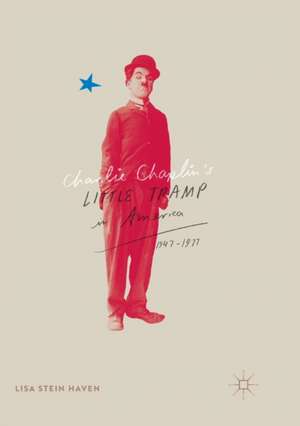Charlie Chaplin’s Little Tramp in America, 1947–77
Autor Lisa Stein Havenen Limba Engleză Paperback – 27 iun 2018
Toate formatele și edițiile
| Toate formatele și edițiile | Preț | Express |
|---|---|---|
| Paperback (1) | 888.63 lei 6-8 săpt. | |
| Springer International Publishing – 27 iun 2018 | 888.63 lei 6-8 săpt. | |
| Hardback (1) | 893.74 lei 6-8 săpt. | |
| Springer International Publishing – 16 noi 2016 | 893.74 lei 6-8 săpt. |
Preț: 888.63 lei
Preț vechi: 1083.68 lei
-18% Nou
Puncte Express: 1333
Preț estimativ în valută:
170.05€ • 178.13$ • 140.93£
170.05€ • 178.13$ • 140.93£
Carte tipărită la comandă
Livrare economică 08-22 aprilie
Preluare comenzi: 021 569.72.76
Specificații
ISBN-13: 9783319821139
ISBN-10: 331982113X
Pagini: 300
Ilustrații: XIV, 300 p. 25 illus.
Dimensiuni: 148 x 210 mm
Greutate: 0.38 kg
Ediția:Softcover reprint of the original 1st ed. 2016
Editura: Springer International Publishing
Colecția Palgrave Macmillan
Locul publicării:Cham, Switzerland
ISBN-10: 331982113X
Pagini: 300
Ilustrații: XIV, 300 p. 25 illus.
Dimensiuni: 148 x 210 mm
Greutate: 0.38 kg
Ediția:Softcover reprint of the original 1st ed. 2016
Editura: Springer International Publishing
Colecția Palgrave Macmillan
Locul publicării:Cham, Switzerland
Cuprins
Preface.- .Introduction: The Death of the Little Tramp and Chaplin in the Aftermath.- .Chapter 1: Bohemian Writers and the Resurrection of the Little Tramp.- .Chapter 2: The Beat Chaplinists.- .Chapter 3: Seeing Charlie: Legal and Illegal Chaplin Screenings.- .Chapter 4: Narrativizing Charlie in Print and Film.- .Chapter 5: Selling Charlie.- .Epilogue: The Little Tramp’s Continuing Longevity, post-1977.
Recenzii
“This volume is a historiographic examination of how the Little Tramp was perceived during this period. The ways in which Chaplin was identified between 1947 and 1977–a time of living memory for some–underpin how the artist and his Tramp are interpreted today and will be in the future. A thoughtful and engaging study, Haven’s book fills a major gap in our understanding of Charlie Chaplin and his art.” (Frank Milo Scheide, Modern Language Review, Vol. 113 (2), April, 2018)
Notă biografică
Lisa Stein Haven is Associate Professor of English at Ohio University Zanesville, USA. She specializes in 20th Century British and American literature and silent film comedy. Her last book A Comedian Sees the World, an edition of Charlie Chaplin’s 1934 travelogue, has been translated into five languages.
Textul de pe ultima copertă
This book focuses on the re-invigoration of Charlie Chaplin’s Little Tramp persona in America from the point at which Chaplin reached the acme of his disfavor in the States, promoted by the media, through his departure from America forever in 1952, and ending with his death in Switzerland in 1977. By considering factions of America as diverse as 8mm film collectors, Beat poets and writers and readers of Chaplin biographies, this cultural study determines conclusively that Chaplin’s Little Tramp never died, but in fact experienced a resurgence, which began slowly even before 1950 and was wholly in effect by 1965 and then confirmed by 1972, the year in which Chaplin returned to the United States for the final time, to receive accolades in both New York and Los Angeles, where he received an Oscar for a lifetime of achievement in film.
Caracteristici
Provides the first extended analysis and narrative of Chaplin's move from maligned to celebrated figure in America Based upon impressive research ranging from primary documents in various archives, original personal interviews, and secondary sources Extends the study Chaplin's legacy in popular and academic circles through the 2010s











